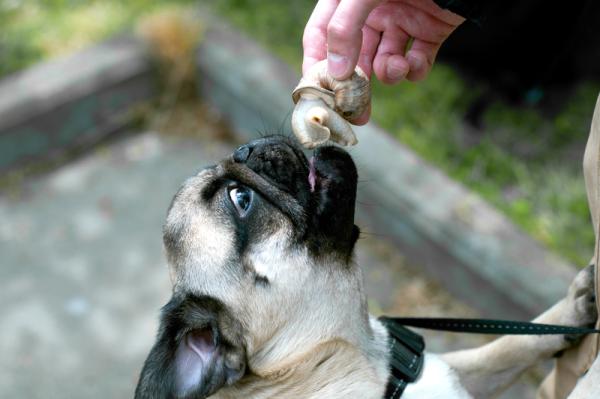Lungworm in Dogs - Symptoms and Treatment



See files for Dogs
When we discuss parasites in dogs, many of us might first think of external parasites such as fleas and ticks. While we are aware of internal parasites, their interiority makes them less visible and it is only when symptoms develop are we aware of their presence. Even at this point, there are many symptoms which can be confused with other health problems. Where the parasite is located is one of the most important factors in determining which symptoms develop. Parasites which infest vital organs such as the lung can cause some of the most life-threatening symptoms.
At AnimalWised, we look at the symptoms of lungworm in dogs, as well as what treatment options are available. We also find out how canine lungworm is diagnosed and what we can do to best prevent it in our animals.
What is lungworm in dogs?
There are various types of internal and external parasites in dogs. While there are others, the most common category of internal parasites in dogs are types of nematodes, i.e. parasitical worms. These often live in the gastrointestinal tract of canines. Symptoms of intestinal worms are mostly related to digestive issues, although they can produce more systemic problems.
Different types of parasite will need to feed on or live in different types of tissue to survive. As their name suggests, lungworms do not live in the gastrointestinal tract. They survive by reproducing in the tissue of the lungs, but can also infest other organs such as the heart. This reproduction can cause serious hinderance to the functioning of the organ, as well as parasitosis diseases which can be fatal in the dog.
Lungworm in dogs appears to be an expansion diseases. These are diseases which appear to be growing in prevalence due to climate and ecosystem changes. Such changes create better conditions in which the diseases can thrive, encouraging the spread of these parasites.
Types of lungworm in dogs
There are various types of nematode that can affect a dog's lung tissue. The most prevalent depend on where you live. In North America, the most common types of canine lungworm are Crenostoma vulpis, Eucoleus aerophilus, Eucoleus boehmi, Filaroides hirthi and Oslerus osleri. French heartworm (Angiostrongylus vasorum) can also attack the lung tissue.
These nematodes are capable of living in the blood vessels of organs such as the lungs and the heart. They arrive at these tissues through the digestive system when the dog ingest their larvae. The larvae are so small they can enter the bloodstream and go through their different life cycle stages. When the dog coughs, they can expel the larvae from the respiratory system. They can then enter the digestive system and be excreted in feces. They can survive for a few days outside the body and this system can be repeated over a period of years.
Lungworm transmission in dogs
Parasites infest hosts, but they don't usually rely on only one of them. Different hosts may contain the parasite at different stages of their lives. Dogs and other types of canine are the most common primary host, i.e. the host where the parasite achieves its adult stage. Snails and slugs are the most common intermediate host. This is the host which contains the sexually immature parasite which cannot mature until it reaches the primary host.
Dogs will often eat slugs and snails because they see them as food. When a slug is an intermediate hostof a lungworm, this will allow them to infest the dog. Dogs can even ingest the larvae from the trails left by these mollusks, as well as from feces of an infested animal. Frogs and other animals can be intermediate hosts of lungworm as the parasite can survive both on land and in water.

Can all dogs get lungworm?
Any dog can potentially become a host of lungworm parasites, regardless of breed or age. However, there are some factors which can predispose a dog to lungworm infection. These factors include:
- Accessibility to slugs and snails: if a dog lives in an area which has larger populations of intermediate hosts, it increases the likelihood of infestation.
- Age: puppies and young dogs are at a greater risk as they are more inquisitory and more likely to eat indiscriminately. They will also have a less-developed immune system.
- Dogs with lowered immunity: whether they have a disease, are in old age or have lowered immunity for whatever reason, their bodies are less able to resist a parasite infestation.
Symptoms of lungworms in dogs
The clinical signs that lungworms can trigger when they infest a dog are often nonspecific. This means they can be symptoms which are otherwise shared with other diseases and conditions. This can complicated a diagnosis, so it is important we be as observant as possible to any changes in our dog's physical or behavioral state.
Depending on the extent of the parasite infestation and other factors, dogs can be asymptomatic. Some may even die suddenly without displaying any obvious symptoms beforehand. When they do present, the signs of lungworm in dogs include:
- Coughing
- Respiratory difficulties
- Secondary pneumonia
- Cyanosis (bluish discoloration of the mucus membranes)
- Tachycardia (increased heart rate)
- heart failure
- Exercise intolerance
- Blood clotting problems (can manifest in hemorrhages, petechiae, ecchymoses, bruises, etc.)
- Neurological alterations (seizures, adoption of abnormal postures, etc.)
- Anorexia
- Appetite loss
- Nausea
- Vomiting
- Diarrhea
- Weight loss
- General malaise
Since many of these symptoms are shared with other health problems, it is important to be specific. Learn more with our article on why a dog has diarrhea and vomiting at the same time.
Diagnosis of lungworms in dogs
A veterinarian can confirm the presence of the lungworm by using various diagnostic tests, but it is important to note that diagnosis is often difficult. Lung auscultation (listening to internal lung sounds) may be normal, but abnormalities consistent with this parasite can be detected by chest radiography, echocardiography, MRI or computed tomography (CT scan).
It is also possible to see alterations in blood tests. These may include anemia, an increase in the number of eosinophils or a decrease in the platelet count. The parasite may also be directly observed in stool, cerebrospinal fluid or from bronchoalveolar lavage. The difficulty in diagnosing lungworm in dogs shows the importance of taking a dog to the veterinarian when we see signs of any abnormalities.
Treatment of lungworms in dogs
The treatment against these parasites involves using the specific anthelmintic drug that eliminates the specific parasite. There are several drugs from which the veterinarian can choose, using that which is most appropriate for the type of lungworm detected. In addition to eliminating lungworms, symptom management is required. The type of treatment will vary depending on the symptoms and severity of each animal.
For example, hospitalization, oxygen therapy, blood transfusions, bronchodilators, diuretics, corticosteroids or other treatments mat be required. This shows the potential complexity of the treatment to be administered and the severity of the damage that the lungworm is capable of causing in dogs. It must also be taken into account that the death of parasites can cause adverse reactions in the body.
Finally, monitoring the dog includes checkups to see if it is free of parasites or is still a reservoir for the parasites. In areas where certain types of lungworm parasites are abundant, it is advisable to check the dogs several times a year for their presence.
Prognosis of lungworm disease in dogs
We cannot give a specific prognosis for an individual dog once they have been diagnosed with lungworm. The prognosis and the dog's ability to recover depend on the specific dog. While dogs can recover from lungworm, this will depend on the damage caused by the nematodes on the tissue of vital organs, the speed with which treatment is administered and the health of the dog. Some dogs may die due to the severe respiratory problems caused by the tissue damage or maintain breathing difficulties during the remainder of their life.

Lungworm in dogs prevention
Given the severity of the clinical signs that these parasites can trigger, the difficulties in their diagnosis, possible treatment complications and their fast spread, the best measure against this type of infestation is prevention. Deworming dogs from when they are a puppy is important, especially as puppies are at greater risk.
There are many different types of internal and external antiparasitic products available, but the best one for your puppy should be determined by your veterinarian. They will be best able to establish a deworming schedule for your dog which is appropriate for their specific needs, as well as the area in which they live. We should take the puppy to a veterinarian as soon as possible after they are born and the vet can then make their first deworming appointment.
We should also establish necessary measures to prevent your dog from ingesting slugs, snails and other potential intermediate hosts of lungworm nematodes. This includes training them not to eat things they find on the street, keeping them on leash in areas with large slug populations, keeping their environment free of feces and anything else which might prevent them from coming in contact with larvae.
To find out the most common parasites in your area, we encourage you to consult the parasite prevalence map of your area. Contact your local animal services or speak to your veterinarian if you are unsure.

This article is purely informative. AnimalWised does not have the authority to prescribe any veterinary treatment or create a diagnosis. We invite you to take your pet to the veterinarian if they are suffering from any condition or pain.
If you want to read similar articles to Lungworm in Dogs - Symptoms and Treatment, we recommend you visit our Parasitic diseases category.
- ESCCAP. (2014). Control of worms in buts and cats. ESCCAP Guide No. 1. Retrieved from: https://www.esccap.es/wp-content/uploads/2015/04/2015_G1_2-ed.pdf







